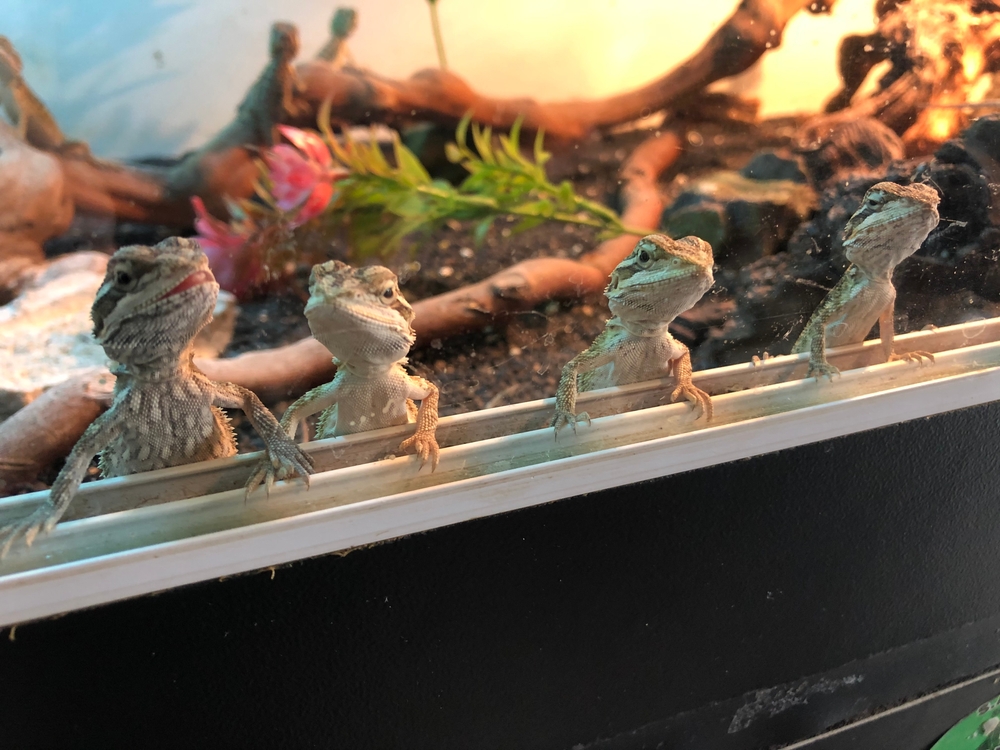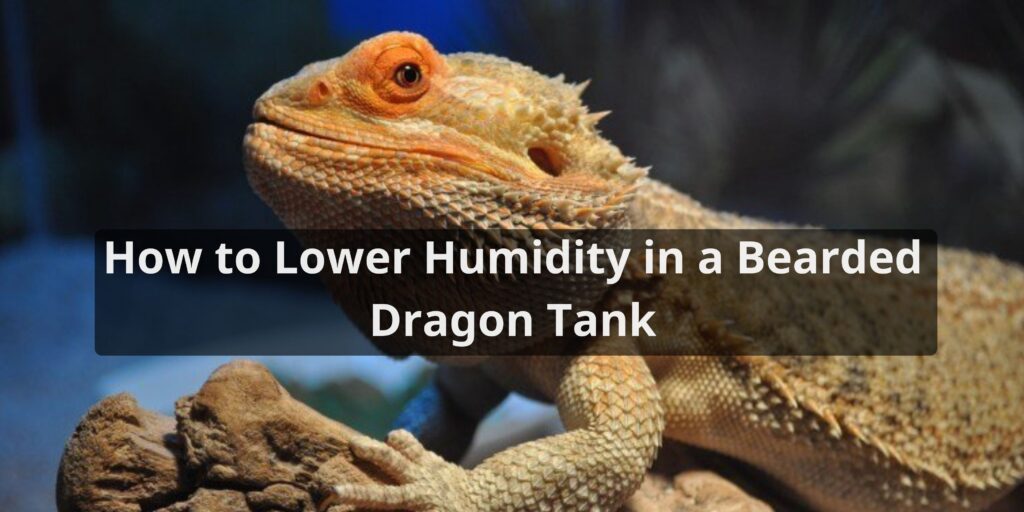Bearded dragons are lizards that originate from Australia’s desert regions. They thrive in warm, dry environments with low humidity. In captivity, bearded dragons require specific temperature and humidity ranges to remain healthy. If the humidity in your bearded dragon’s tank gets too high, it can lead to potentially life-threatening illnesses. Therefore, it’s important for bearded dragon owners to understand how to lower humidity in bearded dragon tank and maintain ideal conditions. This article will provide tips and solutions to reduce humidity in your bearded dragon’s habitat.
Understanding Ideal Bearded Dragon Humidity Levels

Bearded dragons come from arid desert regions that have very low humidity. In the wild, the humidity range is typically 30-40%. As captive pets, bearded dragons do best when the humidity inside their enclosures is kept between 30-50%.
Humidity levels above 50% can put bearded dragons at risk for respiratory infections. Bacteria and fungi thrive in humid environments. Prolonged exposure to high humidity causes stress to a bearded dragon’s immune system. This makes them prone to upper respiratory infections that can lead to life-threatening pneumonia.
Excess moisture also creates unsanitary enclosure conditions. Damp substrates can harbor dangerous molds and fungus. Feces and uneaten food decay faster in humid environments. This allows harmful microbes to multiply quickly.
For the health and wellbeing of your bearded dragon, it’s essential to measure and control humidity. Target levels within 30-50% to prevent illness and keep their habitat clean.
Measuring Humidity in Your Bearded Dragon’s Enclosure
The first step is acquiring an accurate hygrometer to monitor humidity levels inside your bearded dragon’s tank. Hygrometers measure relative humidity (RH). RH is the percentage of water vapor present in air compared to the maximum amount the air can hold at a given temperature.
Digital hygrometers that display RH readings in real-time are the most precise option. Place the sensor in the center of the tank, away from heat sources and water dishes. Take readings at various times of day to determine the enclosure’s humidity range.
Ideally, the RH in a bearded dragon’s tank should fall within 30-50%. If readings are consistently above 50%, adjustments are needed to bring down the humidity.
How to Lower Humidity in a Bearded Dragon Tank

There are several effective methods to reduce humidity in a bearded dragon’s habitat:
1. Adjust the Temperature
- Warmer temperatures decrease relative humidity.
- Raise the basking spot temperature to 105-110°F.
- Make sure the cool end of the tank stays above 75°F.
- Use a stronger wattage bulb to increase heat.
- Adding more heat dries out the tank’s atmosphere.
2. Increase Ventilation
- Stagnant air causes humidity buildup.
- Allow air flow by keeping the tank’s lid partially open.
- Install more vents or widen existing vents.
- Strategically place a small fan to circulate air.
- Cover only 30-50% of the mesh lid with a towel to trap heat.
3. Use a Dehumidifier
- Mechanical dehumidifiers remove moisture from the air.
- Choose a small electric dehumidifier and place it near the tank.
- Replace the water reservoir frequently as it collects condensation.
- Maintain 30-50% RH in the room to also lower tank humidity.
4. Add a Moisture-Absorbent Substrate
- Some substrates draw moisture out of the air and dry surroundings.
- Replace any damp substrates with ones like reptile carpet or paper towels.
- Add substrates like coarse sand, wood shavings, crushed walnut shells.
- Avoid calcium carbonate sands, which increase humidity.
5. Use Household Desiccants
- Desiccants are drying agents that absorb moisture.
- Place containers of desiccant crystals, rice, or charcoal in the tank.
- Bake unsweetened clay kitty litter to use as a natural desiccant.
- Replace desiccants regularly as they become saturated with moisture.
Creating an Ideal Low Humidity Bearded Dragon Habitat
Properly setting up your bearded dragon’s enclosure goes hand-in-hand with controlling humidity. Here are some key tips:
- Select an adequately sized glass tank, at least 55-75 gallons for adults.
- Use substrates like reptile carpet, paper towels, or tile. Avoid sand or moss.
- Include hides and branches for climbing but don’t overcrowd the tank.
- Place the basking area at one end and the cool zone at the other.
- Use an under tank heater on one side to create a heat gradient.
- Keep multiple thermometers and hygrometers to monitor temperature and humidity.
- Ventilate the tank well but avoid drafts.
Getting the environment right takes some trial and error. Check humidity frequently and make adjustments as needed. Maintaining proper temperatures and low humidity levels will go a long way in keeping your bearded dragon healthy!
Signs of High Humidity and Potential Health Issues
Here are some signs that the humidity in your bearded dragon tank is too high:
- Hygrometer readings consistently above 55%
- Condensation collecting on the tank walls and lid
- Substrate or decorations feeling damp
- A “muggy” feel when opening the tank
- Evidence of mold/fungus growth
- Musty smells from the enclosure
- Increased shedding or retained eye caps in your bearded dragon
Prolonged exposure to high humidity puts bearded dragons at risk for:
- Respiratory infections like pneumonia
- Skin and shell infections
- Mouth rot and eye infections
- Tail rot due to scale fungi and bacteria
- Dysecdysis, which isincomplete shedding
Take corrective action right away if you notice any signs of ill health related to high humidity. Vet treatment may be required for respiratory, skin, or eye infections.
Conclusion
Maintaining proper humidity levels is imperative to your bearded dragon’s health and wellness. Use a hygrometer to monitor humidity in the tank and make adjustments as needed. Raising temperatures, increasing ventilation, adding desiccants, and using moisture-absorbent substrates can all help lower humidity. Shoot for a 30-50% humidity range to prevent dangerous conditions and illnesses. With some diligent monitoring and tweaks to their habitat, you can provide your bearded dragon with the ideal dry environment they need to thrive.
FAQs About How to Lower Humidity in Bearded Dragon Tank
Can high humidity levels harm my bearded dragon?
Yes, high humidity can lead to respiratory infections, skin issues, and discomfort for your bearded dragon. Maintaining proper humidity is essential for their health.
What steps can I take to lower humidity in the tank?
Increase ventilation, reduce water dish size, limit misting, choose dry substrate, and ensure proper tank insulation to lower humidity levels.
Are there specific tank modifications or equipment to reduce humidity?
Adding additional vents, using a dehumidifier in the room, or adjusting heating and lighting to reduce condensation can help lower humidity.
How does tank ventilation impact humidity levels?
Improved ventilation helps lower humidity by allowing moisture to escape. Ensure airflow without causing drafts that could stress your dragon.
What role does substrate choice play in controlling humidity?
Choosing a dry substrate like reptile carpet or paper towels helps maintain lower humidity levels compared to substrates like cypress mulch, which can retain moisture.
Are there any long-term strategies for maintaining lower humidity in a bearded dragon tank?
Long-term strategies include selecting humidity-resistant tank materials, maintaining a regular cleaning routine, and monitoring humidity consistently to make necessary adjustments.



